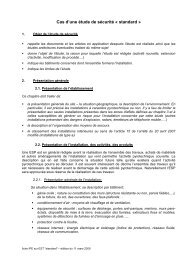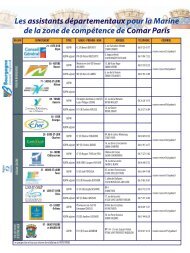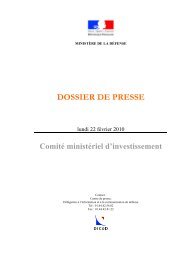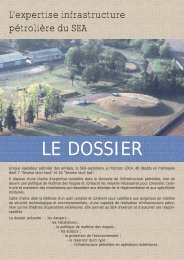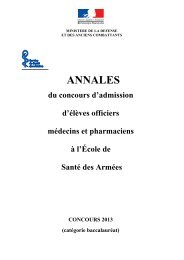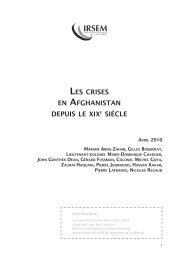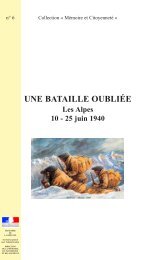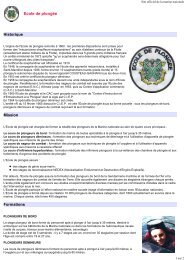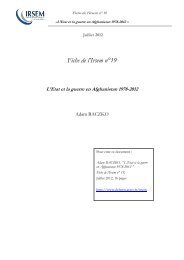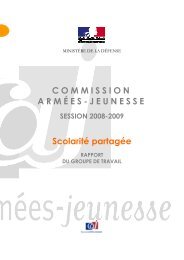Rapport Védrine_ENG_GERMAN - Ministère de la Défense
Rapport Védrine_ENG_GERMAN - Ministère de la Défense
Rapport Védrine_ENG_GERMAN - Ministère de la Défense
Erfolgreiche ePaper selbst erstellen
Machen Sie aus Ihren PDF Publikationen ein blätterbares Flipbook mit unserer einzigartigen Google optimierten e-Paper Software.
I. EVALUATION<br />
1. HISTORY OF RELATIONS BETWEEN FRANCE AND NATO<br />
A. The At<strong>la</strong>ntic Alliance was created in Washington on 4 April 1949, with the signature of the “North<br />
At<strong>la</strong>ntic Treaty”. The signature came after the Truman administration managed to persua<strong>de</strong> the<br />
American Senate, which was reluctant to make a binding commitment unlike any other in the history of<br />
the United States. This commitment was the one contained in Article 5 of the Treaty:<br />
“The Parties agree that an armed attack against one or more of them in Europe or North America shall<br />
be consi<strong>de</strong>red an attack against them all and consequently they agree that, if such an armed attack<br />
occurs, each of them, in exercise of the right of individual or collective self-<strong>de</strong>fence recognised by Article<br />
51 of the Charter of the United Nations, will assist the Party or Parties so attacked by taking forthwith,<br />
individually and in concert with the other Parties, such action as it <strong>de</strong>ems necessary, including the use<br />
of armed force, to restore and maintain the security of the North At<strong>la</strong>ntic area.”<br />
In the post-war period, France had worked to bind the United States to Western Europe in a permanent<br />
alliance, so as to avoid a repeat of the experience in the nineteen-twenties, to protect Western Europe<br />
from the Soviet threat and, without actually saying so, <strong>de</strong>al with the German question. Naturally, France<br />
was one of the twelve founding members of the Alliance, as well as one of the most active.<br />
The Treaty Organisation per se, which is the “O” in NATO, was not set up until two years <strong>la</strong>ter, in April<br />
1951, in response to the traumatic surprise Chinese and Soviet attack on Korea in June 1950. The<br />
purpose was to organise the Allies’ military forces in Western Europe in peacetime so that they could<br />
respond promptly to any Soviet attack, as if they were already in wartime. This gave rise to integration<br />
and Pentagon control of p<strong>la</strong>nning and the chain of command. The United States imposed these<br />
changes without encountering any protest and the Supreme Allied Comman<strong>de</strong>r Europe (SACEUR) has<br />
always been an American. General Eisenhower served briefly as the first SACEUR, before being<br />
elected Presi<strong>de</strong>nt of the United States in 1952. The Supreme Headquarters of the Allied Powers in<br />
Europe (SHAPE) was set up at Rocquencourt. After the French Parliament’s vote on 30 August 1954<br />
rejected the European Defence Community (EDC), which was an unsuccessful European and American<br />
ploy to get French politicians to accept German rearmament, West Germany was admitted to NATO in<br />
May 1955. The members at the time, in addition to the United States, were Belgium, Canada, Denmark,<br />
France, Italy, Ice<strong>la</strong>nd, Luxembourg, Norway, the Nether<strong>la</strong>nds, Portugal, the United Kingdom, Greece<br />
and Turkey (since 1952), and now Germany.<br />
B. General <strong>de</strong> Gaulle’s <strong>de</strong>cision to leave the integrated military command.<br />
On 17 September 1958, General <strong>de</strong> Gaulle, who was France’s Presi<strong>de</strong>nt of the Council (Prime Minister)<br />
at the time, sent a Memorandum to Presi<strong>de</strong>nt Eisenhower and Prime Minister Macmil<strong>la</strong>n calling for a<br />
tripartite directorate of the Alliance, ma<strong>de</strong> up of the United States, the United Kingdom and France, and<br />
a global, rather than an At<strong>la</strong>ntic, vision of their security. Despite three-party discussions <strong>la</strong>sting for three<br />
years after this move, neither J. F. Kennedy, who had actually spoken of a “European pil<strong>la</strong>r” of the<br />
3



